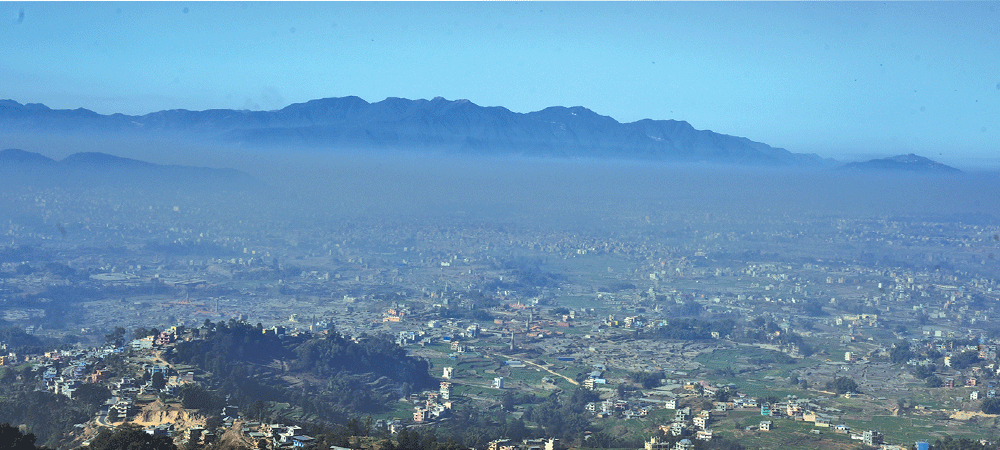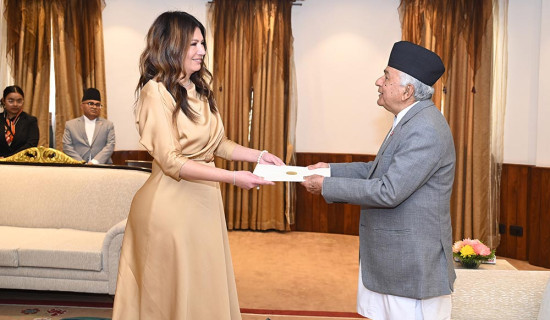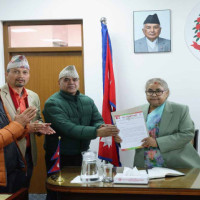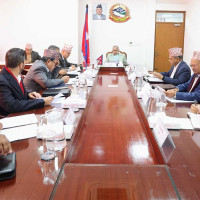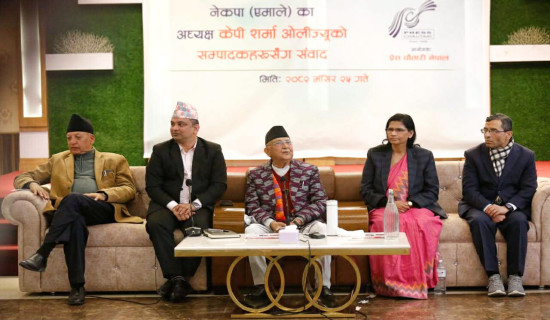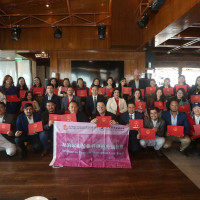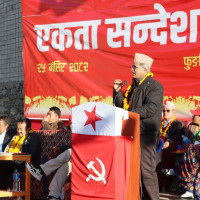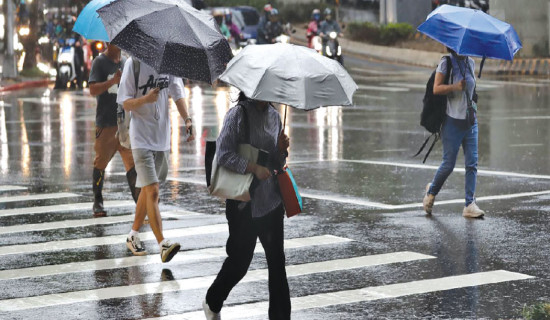- Thursday, 11 December 2025
Road digging, drought aggravate dust pollution
Kathmandu, Feb. 16: Rupa Khatri, a resident of Jadibuti, faces a tough time all day long due to billowing clouds of dust from the road that passes by her home.
Roads have remained dusty for the past couple of months in the area as the Nepal Electricity Authority (NEA) has dug the secondary road of the Jadibuti-Purano Thimi road section for laying electric wires underground.
She said she could not breathe while passing along the road. “Many of us got sick due to the dust. We cannot even stay home without closing our windows,” she said.
A fruit shopkeeper in the Jadibuti section Raaj Sah said that he was struggling to keep his fruit fresh. Even if he wipes dust off his fruits they turn the same in 30 minutes. He complained that even the buyers did not understand his problem, they asked him why his fruits looked dull and not fresh.
Purna Kumari Sharma of Budanilakantha is an asthma patient. But for the last three months, she has been suffering from a cough. She even visited a doctor and the doctor suggested her avoid smoke and dust.
“I am a permanent resident of Budhanilakanta so how can I avoid dust as there is a damaged road in front of my house? I don’t know who did this but this is irresponsible on part of the organisation,” Sharma said.
These are only a couple of cases of people fed up with the dusty road in the Kathmandu district. Organisations like NEA and Kathmandu Upatyaka Khanepani Limited (KUKL) are digging roads in various parts of Kathmandu in the name of laying electricity wires and drinking water pipes but they never seem to make the road like earlier.
Due to the lack of necessary coordination between the NEA and the Department of Roads, the extension of the underground electric lines has become more problematic. The project was inaugurated by the then Prime Minister KP Sharma Oli on February 17, 2020, at a formal programme.
Besides, various parts of the country including Kathmandu did not receive rain for the past four months. Unmanaged roads in various sections create problems for commuters and residents.
According to Pulmonologist Dr. Niraj Bam, chief at the Department of Pulmonology and Critical Care Medicine, Kathmandu is already a polluted city and with the unmanaged development works, it is creating more problems to the people.
“The dust pollutants have short-term and long-term effects. In the short term, it will help increase PM 2.5 pollutants (tiny particles or droplets in the air that are two and one-half microns or less in width) in the air, and this causes flu, common cold and cough, asthma, and eye problem while in the long it can cause lung cancer, hair fall, psycho-depression, pressure and stroke,” Dr. Bam said.
He suggested the concerned authorities should follow the demolishing and development works together so that people do not have to face extra pollution burden.
Environmentalist Dr. Bhupendra Das said that there has been no research about the cause of the dust pollution, but it will certainly lead to an increase in the PM 2.5 and PM 10 (particulate matter {PM} includes microscopic matter suspended in air or water. It includes particles less than 10 µm in diameter). The construction of houses and digging roads and sideway paths for the expansion of drinking water services increase dust pollution, especially in the city areas and has become the biggest issue in the Kathmandu Valley, Dr. Das said.
According him, the dust with fossil fuel produces black carbon (formed by incomplete combustion of fossil fuels, wood and other fuels) which then leads to temperature rise. Meanwhile, the NEA said it was planning to construct about 250 km of 11,000 voltage underground line and about 400 km of 4,000 kVA underground line under the Maharajgunj distribution centre which covers areas such as Baluwatar, Budhanilakantha, Tokha, Gongabu, and Maharajgunj. NEA also plans to lay about 250 km of optical fibre underground in the area. These areas will face the problem of dust once the NEA begins its works there.
In the areas like Teku, Tripureshwar, Thapathali, Maitighar, New Baneshwar, Tinkune-Sinamangal and Tribhuvan International Airport, which are under the Ratnapark distribution centre, the laying of electric lines underground has not been started as the NEA has to receive permission from the DoR.
Narayan Nihure, Project Manager/Senior Divisional Engineer (SDE) at the DoR, said that permission would be granted only after completing the earlier task. They have to complete the task of one section within 45 days. “An agreement has been made that they have to restore the road to its original state after completing them within the given time but that is not happening now.
So we are holding a discussion and meeting with the concerned authorities about the delayed work,” he said.
If they do not complete the work within the set period, a new contract will be announced, he added.
When asked about putting down electricity wires and road conditions, NEA officials did not want to respond.
Tara Pradhan, an official at NEA, said that they are not the ones who dig the road but the contractor. He said they have given responsibility to various contractors and if not completed on time, they will grant the contract to some other agencies.
But time has already passed by. While trying to contact KUKL officials, they also shifted the responsibility to one from another. But no one was willing to talk about the issue.

